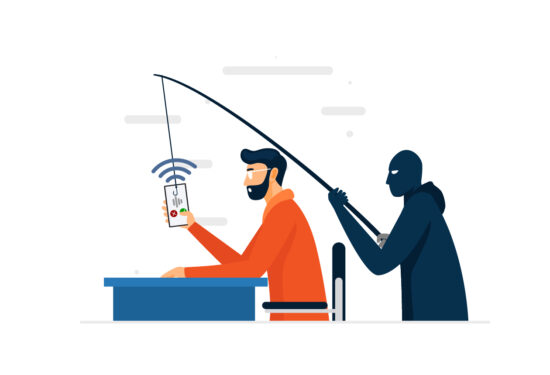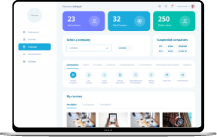The Difference Between Phishing Attacks
Phishing attacks are harmful attacks used by criminals to steal personal and financial information from individuals and businesses.
Attacks on individuals and businesses are becoming more common as we use the internet and technology more often in our daily lives.
Phishing attacks involve the use of dishonesty and fraudulent methods to fool consumers into believing they are interacting with the trustworthiness of an unsuspecting destination, such as banks, email companies, or social media platforms.
But what is the difference between phishing attacks?
How can individuals and organizations protect themselves from such attacks?
That is what this article will cover.
What Are The Most Popular Types of Phishing Attacks?
Perhaps the most famous types of phishing scams are:
Phishing via SMS messages (smishing)
Phishing via e-mail (Phishing)
Phishing over Voice communication (Vishing)

These attacks are similar in the usage of fraudulent methods to trick users into providing attackers with personal and financial information.
There are, however, some significant variations between these attacks.
Text message Phishing (Smishing):
Short text messages (SMS) are used in these attacks to trick users into clicking on a suspicious link or sharing personal and financial information.
For example, attackers could send a text message claiming to be from the bank, asking the user to update the bank account information through a link, and then redirecting the user to a false website to collect sensitive information.
Phishing via e-mail (Phishing):
Fake emails are used in these attacks to trick users into thinking they are interacting with a trustworthy organization, such as a bank or an email provider.
A strange link is often found in e-mails, directing users to a fully fake Phishing e-mail Web page that collects users’ personal and financial information.
Phishing over Voice communication (Vishing):
Voice telephony is used in these attacks to trick users into thinking they are interacting with a trustworthy organization, such as a bank or a financial services company.
To get users to share personal and financial information, such as a bank account PIN, National Identification number, or OTP number, voice manipulation and fake information methods are used.
What Are The Main Dangers of Phishing Attacks?
Phishing attacks may cause a variety of challenges, including:
Theft of personal information:
Attackers can use Phishing attacks to obtain users’ personal information, such as names, addresses, national identification numbers, bank account details, credit card details, and these information can be used for forgery and other fraud.
Financial fraud:
Attackers can use phishing attacks to steal money or transfer it to other accounts using the personal information obtained or by persuading users to provide their financial information.
Reputation damage:
Phishing attacks can damage the reputation of targeted organizations and companies due to the use of their name and logo in fake attacks.
Electronic penetration:
Phishing attacks can lead to electronic penetration of devices and networks, due to which users open suspicious links or upload malicious files.
Waste of time and resources:
Dealing with phishing attacks can lead to a loss of time and resources as organizations and individuals must conduct verification and investigation and take the necessary security measures, which can affect productivity and efficiency.
Psychological damage:
Exposure to phishing attacks can cause psychological damage to individuals and organizations, especially if there are significant financial or information losses.
Legal violations:
The use of phishing attacks can lead to legal violations due to electronic hacks and the use of stolen information in fraud, forgery, and theft.
Ways to Protect Against Phishing Attacks.
There are many strategies for protecting against phishing attempts, including:
Verifying the identity of the issuer:
The identity of the issuer must always be verified before providing any personal or financial information , the alleged party can be contacted directly to verify the correctness of the information provided.
Do not click on suspicious links:
You should avoid clicking on suspicious links in emails and text messages and not upload unknown files.
Update protection software:
Anti-virus and malware software should be installed and updated regularly to ensure better protection of devices and data.
You should use strong and unique passwords for each account and avoid using easy to predict passwords such as date of birth or consecutive numbers.
Training and digital awareness:
Employees and users should be made aware of the methods of phishing attacks, trained on how to deal with them, verify the identity of the source, and avoid clicking on suspicious links.
Using security applications:
Security applications such as two-factor authentication applications and password management applications can be used to increase security and protect against phishing attacks.
Hardware and software updates:
Hardware and software should be updated regularly to correct security vulnerabilities and enhance protection.
Caution about personal information on social networking sites:
Caution should be exercised when it comes to personal information posted on social networking sites, as it can be used by attackers in phishing attacks.
Stay away from public networks:
You should avoid using open and anonymous public networks, as attackers can gain access to sensitive data sent and received.
Report suspicious activity:
Any suspicious activity should be reported to the relevant authorities, such as banks, email companies, or government agencies, to take the necessary measures to protect users.
Conclusion
In short, phishing attacks pose a serious threat to individuals and organizations, and you need to take measures and precautions to protect against them.
Among these measures is the multi-factor authentication system, which provides better and more secure protection for systems and employees from these attacks.
Cerebra developed mPass, a multi-factor authentication system that provides high level protection for users while maintaining ease of use.
If you want to protect yourself or your organization from phishing attacks, you can consider using mPass from Cerebra as a reliable and effective security solution.
It is an important step to protect yourself, your money, and your personal information from the risk of fraud and phishing.
Share this article:
Popular

Revolutionize Enterprise Communication Platform with LinQ2
Revolutionize Enterprise Communication Platform with LinQ2 In today’s fast-paced business environment, enterprise communication platform is the backbone of success. Whether reaching customers, coordinating with employees, or automating notifications, having an effective enterprise communication platform is essential. Cerebra’s LinQ2 stands out as the ultimate solution, offering a multi-channel notification platform tailored for businesses of all sizes. Why Enterprise Communication Platform Is Essential for Business Growth? Efficient enterprise communication platform ensures businesses can stay connected with their customers and teams in real time. Poor communication systems often lead to missed opportunities, customer dissatisfaction, and delays in internal operations. Key Features of LinQ2 ...
11th Mar 2025
Deepfake in Phishing: Challenges and Solutions
In the era of advanced technologies, especially with the explosive adoption of Large Language Models (LLMs) and Generative Artificial Intelligence (GenAI), deepfake has emerged as one of the most significant challenges in cybersecurity. This technology relies on Artificial Intelligence, specifically deep learning and the use of GenAI, to create fake yet highly realistic content that is difficult to detect. Deepfake serves as a versatile tool spanning applications from entertainment to cybersecurity. However, its misuse can pose severe risks, especially in phishing schemes. What is Deepfake? Synthetic media refers to a technology that leverages deep learning algorithms to create ...
19th Dec 2024
AI Governance: Opportunities and Challenges in Cybersecurity
AI Governance: Opportunities and Challenges in Cybersecurity With the increasing reliance on AI technologies in various fields, AI Governance has become a key factor to ensure system integrity and data protection. This governance plays an essential role in enhancing confidence in modern technology and ensuring that it is used responsibly. It has been almost two years since OpenAI’s ChatGPT went viral, igniting widespread interest in artificial intelligence (AI) and setting off a wave of technological and investment growth in the field. Academic and technical investments in artificial intelligence: The advancements in AI since then have been staggering, with exponential increases ...
14th Nov 2024
Cyber Warfare Unveiled: Tracing the Journey from Espionage to Digital Combat
“Cyber Warfare: From Espionage to War A Journey Through Time” With the massive technological advancements, the boundaries of warfare have expanded to encompass cyberspace, where “cyber warfare” has emerged as an increasingly serious threat to individuals, institutions, and countries. The line between cyber and traditional wars has blurred for a while but recent activities in the region made it clear that cyberwars is becoming a dangerous and can lead to harming humans. In this blog, we will dive into a journey through the world of cyber warfare, seeking to understand its nature, history, impacts, types, evolution, and some solutions to ...
9th Oct 2024
Keeping Our Kids Safe Online
A Guide For Keeping Your Kids Safe Online Parents and all who are concerned about the well-being of our young kids in this digital world. Today we will discuss a topic of utmost importance: digital safety for kids. Yes, the Internet can be a very dangerous place for our young kids , especially with the spread of phishing scams. So, let us dive deeper and present to you, in this comprehensive article, a comprehensive guide on digital safety for kids. What every parent needs to pay attention to. Internet risks for kids: The internet has become a big part of ...
17th Jul 2024
Could you be hacked through Slack?
Could you be hacked through Slack? The usage of collaboration platforms such as Microsoft Teams and Slack has significantly increased, with nearly 80% of employees utilizing them. These platforms are designed to be convenient and easily manageable for daily conversations within organizations. However, what makes them easy and convenient also renders them vulnerable to cyber threats and attacks. In 2021, for instance, 780 gigabytes of data from the gaming giant Electronic Arts (EA) were breached through Slack! During the same year, a security vulnerability in Microsoft Teams was exploited to launch a widespread cyber attack on ...
12th Jun 2024
Tips To Be Cyber Protected While Traveling
Goodbye worry! A safe journey in the digital world With all the modern wonders of the digital world, we trust communication technologies on our journeys. There is no doubt that the travel experience is always more beautiful and enjoyable, but it can also pose a range of risks, especially when it comes to cybersecurity. Travelers may fall victim to phishing, Wi-Fi network spying, and theft of their personal data, which can make their journey filled with worries and tension. With the increasing prevalence of cyber threats, it is essential for travelers to follow some guidelines to protect their devices and ...
1st Apr 2024
Push Authentication: A New Era in Multi-Factor Authentication
Want To Say Goodbye To Passwords and OTP Codes? Discover Push Authentication! It is easy for your password to be compromised through phishing attacks, even if it meets the cybersecurity strong password standards and is difficult to predict So we must get to know the technique of Push based Authentication. Some may recommend that you use Multi-Factor Authentication (MFA) to increase your security. Multi-Factor Authentication (MFA): MFA is the process of logging into your account through multiple steps. It requires you to enter more information, not just your password. But there is another obstacle that arises when using such ...
14th Feb 2024
Understanding of the Vishing Meaning
Understanding of the Vishing Meaning Vishing, a combination of “voice” and “phishing,” is a sophisticated form of cybercrime that exploits voice communication to trick individuals and extract sensitive information. In this comprehensive guide, we will explore the meaning of it, the dangers associated with it, and effective methods to protect yourself against these malicious attacks. What is Vishing meaning? Vishing refers to the fraudulent practice of using telephone services to trick individuals into revealing personal and financial information. Scammers often pose as trusted organizations or individuals to gain their victims’ trust. By using social engineering tactics and manipulating ...
5th Jul 2023









